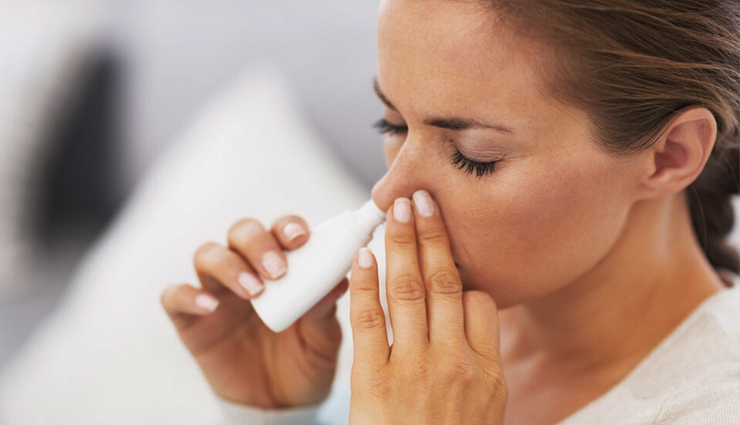- Home›
- Healthy Living›
- 9 Remedies To Reduce The Secretion Of PHlegm Without The Use Of Medicine
9 Remedies To Reduce The Secretion Of PHlegm Without The Use Of Medicine
By: Priyanka Maheshwari Thu, 15 Apr 2021 12:29:49

Phlegm is not a health problem but a symptom of some underlying respiratory infection, inflammation, allergy, or chronic respiratory illness.
The excessive presence of this sticky substance in your nose, throat, airways, and lungs does not, usually, pose any danger to your body but can give rise to breathing discomfort.

# Gargle with warm salt water
Give your clogged throat a deep rinse with warm saline solution. The gentle heat and gargling action will help breakdown the phlegm inside your throat while the salt works as a disinfectant.
Once the phlegm loosens, it can easily be spat out with the water. Gargling also helps eliminate potential allergens such as dust, bacterial and fungal spores from the throat.
- Add a quarter to a half teaspoon of table salt or sea salt to a cup of warm water.
- Stir the liquid until the salt dissolves completely.
- Check the temperature of the solution to make sure it won’t burn your mouth.
- Now take a sip of the solution, gargle with it for a few minutes and then spit it out.

# Use a nasal saline spray or drops
Nasal sprays or drops can help relieve phlegm buildup inside your nose and restore proper breathing. They contain salt water which helps thin out and loosen the sinus mucus, making it easier to drain out of the nasal cavity.
Moreover, this hydrating solution helps rinse the nasal passages and keeps the mucus from crusting or solidifying.
- Pour 1 cup (240 mL) of distilled water into a sterile bottle or container. In case you only have tap water available, boil it and then let it cool to room temperature before using it.
- Mix ½ tsp (2.5 g) salt and the same amount of baking soda into the water.
- Finally, pour this saline solution into the bottle and store it at room temperature. This solution will last you for 3 days.

# Consume honey for phlegm-relief
Honey is a natural humectant that can dilute or loosen mucus to facilitate its easy expulsion. This remedy has been found particularly useful in reducing wet cough in children.
- You can consume a single tablespoon of raw honey.
- You can prepare a soothing tea by mixing a tablespoon of lemon juice with a tablespoon of honey and adding it to a glass of hot water.

# Use curcumin medicinally
The main component of turmeric is curcumin, which is credited with significant anti-inflammatory properties that can help reduce thick mucus hypersecretion and improve lung function, particularly in patients with asthma.
- You can fry 6–12 g of turmeric powder in ghee and consume it to relieve asthma symptoms.
- You can mix some turmeric powder in warm milk and drink this tonic to curb phlegm secretion.

# Ginger tea and candies may help
Ginger has been extensively used for easing a cough, sore throat, and chest congestion, but there isn’t enough scientific evidence to confirm its therapeutic effects.
Nevertheless, there are countless users who have registered considerable relief after using this herb for addressing their phlegm-related complaints.
The effectiveness of ginger in curbing excessive mucus secretion may be due to its inherent antibacterial and anti-inflammatory properties.
- You can suck on a small chunk of raw ginger or candied ginger.
- Prepare a soothing cup of ginger tea by steeping the herb in hot water for a few minutes, and drink this beverage like a tonic to relieve phlegm-induced congestion.

# Eat spicy foods
One simple way to ease phlegm removal is by consuming foods with a heavy dose of chili in it. The characteristic heat of chili peppers comes from their main bioactive component capsaicin.
This heat can help dissolve and loosen the thickened phlegm, making it easier to cough out. While capsaicin helps in thinning the mucus, it also stimulates the production of extra mucus resulting in an increasingly runny nose.
How to use: Include spicy foods in your regular diet, but only if you don’t have pre-existing gastrointestinal problems which can get exacerbated by increased chili intake.

# Try breathing exercises
One oft-recommended breathing exercise for phlegm expulsion is the airway clearance technique, which involves drawing the phlegm to the back of your throat and then coughing it out.
Coughing is mostly an involuntary reflex to expel an irritant inside your respiratory tract, but it can be performed in a controlled manner to rid the lungs of excessive phlegm.

# Practice huff coughing
This involves deeply inhaling air into your lungs, holding it in, and then actively exhaling to cough out the phlegm.
Drawing a deep breath and holding it in allows the air to get behind the phlegm and dislodge it from the lung walls. You can then expel the loosened phlegm from the lungs through forceful exhalation or coughing.

# Steam with essential oils
Steam inhalation is a standard method for clearing phlegm buildup in the respiratory tract, but it might prove even more effective if you add a few drops of therapeutic essential oils to the water.
These oils are extracted from various medicinal plants and exhibit significant health-promoting effects which can facilitate faster recovery from chest congestion.
- Boil some water and pour it in a clean bowl.
- Add a few drops of peppermint/chamomile/tea tree oil.
- Check the temperature of the steam to make sure it’s not too hot, and then hold your face above the bowl with a towel on top to keep the steam from escaping.
- Breathe in the vapors for a few minutes to loosen the phlegm and then cough it out later.





